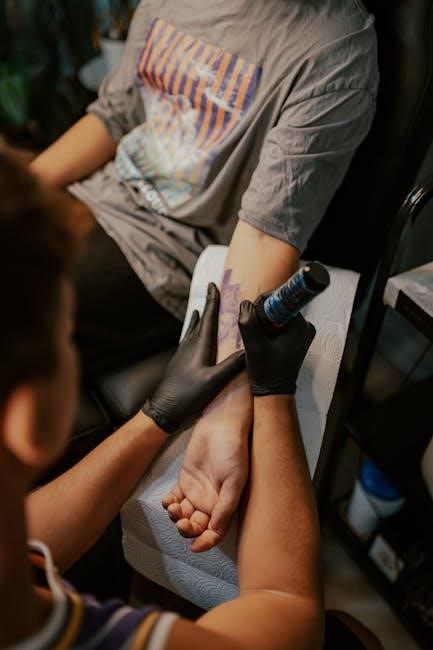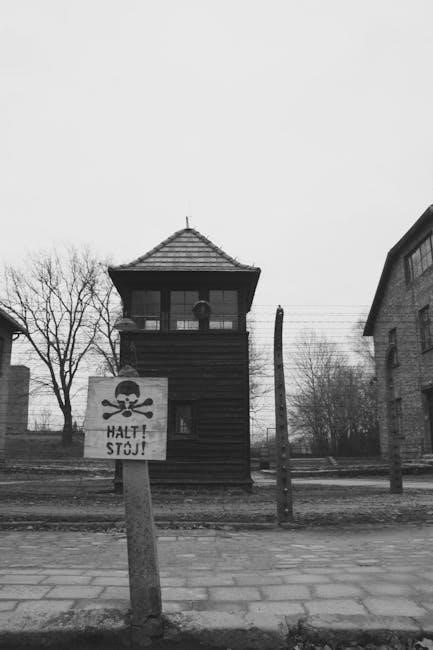Background of “The Tattooist of Auschwitz”
The Tattooist of Auschwitz‚ a novel by Heather Morris‚ is based on the real-life story of Lale Sokolov‚ a Slovakian Jew imprisoned in Auschwitz in 1942. Published in 2018‚ the book recounts Lale’s harrowing experiences as a tattooist in the concentration camp and his unforgettable love story with Gita‚ a fellow prisoner. The novel has become an international bestseller‚ praised for its emotional depth and historical significance. The story‚ rooted in interviews with Lale before his death in 2006‚ offers a poignant tale of survival‚ hope‚ and humanity amidst one of history’s darkest chapters. The book is widely available in PDF format across various platforms‚ though readers are encouraged to access it through legal and ethical sources to support the author and publishers.
1.1 Publication Details
The Tattooist of Auschwitz was published in 2018 by HarperCollins. The novel‚ written by Heather Morris‚ spans 288 pages and is part of The Tattooist of Auschwitz series. Available in print‚ ebook‚ and PDF formats‚ the book has become an international bestseller. Readers can access the PDF through platforms like Perlego‚ ensuring legal and ethical downloading. Its emotional depth has resonated globally‚ making it a cherished historical fiction novel.
1.2 The Real-Life Story Behind the Novel
The Tattooist of Auschwitz is rooted in the true story of Lale Sokolov‚ a Slovakian Jew imprisoned in Auschwitz in 1942. As the camp’s tattooist‚ Lale inked numbers on prisoners‚ including Gita‚ whom he later married. Heather Morris spent three years capturing Lale’s story‚ creating a narrative that highlights love‚ survival‚ and humanity amidst the Holocaust’s horrors‚ ensuring his legacy endures for future generations.
Author Heather Morris
Heather Morris‚ a New Zealand author‚ crafted The Tattooist of Auschwitz from Lale Sokolov’s true story‚ creating an international bestseller that also inspired a TV series.
2.1 Heather Morris’s Inspiration for the Book
Heather Morris drew inspiration from the true story of Lale Sokolov‚ a Holocaust survivor and Auschwitz tattooist. After conducting extensive interviews with Sokolov over three years‚ Morris was deeply moved by his harrowing experiences and the enduring love story with his wife‚ Gita. This emotional connection compelled her to craft a novel that honors their resilience and humanity‚ ensuring their story would never be forgotten.
2.2 Her Research and Interviews with Lale Sokolov
Heather Morris meticulously researched Lale Sokolov’s life through interviews conducted over three years. These intimate conversations revealed his harrowing experiences as Auschwitz’s tattooist and his profound love for Gita. Morris’s dedication to capturing his voice and story ensured the novel’s authenticity‚ offering readers a vivid portrayal of survival‚ hope‚ and humanity in the face of unimaginable adversity.
Historical Context of Auschwitz
Auschwitz‚ established in 1940‚ was a Nazi concentration camp where millions were exterminated. It operated through forced labor and systematic murder‚ with tattooists playing a crucial role in marking prisoners‚ a practice that became a haunting symbol of the Holocaust.
3.1 Auschwitz Concentration Camp Overview
Auschwitz‚ established in 1940‚ was a Nazi concentration camp in Poland‚ serving as a site for mass extermination and forced labor. It became a symbol of the Holocaust‚ where millions were systematically murdered. The camp operated until January 1945‚ when Soviet forces liberated it‚ uncovering the atrocities committed. Auschwitz played a central role in the Nazi genocide‚ leaving an indelible mark on history.
3.2 The Role of Tattooists in the Camp
Tattooists in Auschwitz were responsible for marking prisoners with identification numbers‚ a dehumanizing process that stripped victims of their individuality. These tattooists‚ often prisoners themselves‚ held a unique yet morally complex role‚ forced to serve the Nazi regime while witnessing the brutal treatment of fellow inmates. Their work was both a tool of oppression and a means of survival within the camp’s harsh environment.
Lale Sokolov‚ the novel’s protagonist‚ used his role to connect with others‚ including his future wife Gita. His story highlights the psychological toll of this duty‚ as well as the subtle acts of resistance and humanity that persisted even in such conditions. The tattoos became symbols of both suffering and resilience‚ forever etched in the history of Auschwitz.

The Love Story of Lale and Gita
Lale and Gita’s love blossomed in Auschwitz‚ where Lale‚ a tattooist‚ first met Gita while tattooing her number. Despite the horrors‚ their bond grew‚ and they vowed to survive and marry‚ a promise they fulfilled after liberation‚ enduring a lifelong love that transcended the Holocaust’s darkness.
4.1 How Lale and Gita Met
Lale Sokolov‚ a Slovakian Jew and tattooist at Auschwitz‚ met Gita while tattooing her identification number in 1942. Despite the brutal surroundings‚ their connection was instantaneous. Lale‚ captivated by Gita’s courage and beauty‚ vowed to survive and protect her. Their meeting marked the beginning of a profound love story that endured the horrors of the camp and beyond‚ becoming a symbol of hope amidst despair.
4.2 Their Vows of Survival and Marriage
Lale and Gita made a profound vow to survive Auschwitz together‚ their bond strengthened by the harsh conditions. Lale promised to protect Gita‚ while she became his source of hope. They envisioned a future beyond the camp‚ with marriage as their ultimate goal. Their commitment to each other became a beacon of strength‚ fueling their resilience and determination to overcome the unimaginable horrors they faced side by side.
The Tattooist’s Role in the Camp
Lale Sokolov‚ as the camp’s tattooist‚ was tasked with marking prisoners with identification numbers‚ a role that granted him unique privileges yet exposed him to daily horrors.
5.1 Lale’s Responsibilities as a Tattooist
Lale Sokolov’s role as a tattooist in Auschwitz involved marking prisoners with identification numbers‚ a task imposed by the Nazi authorities. He was instructed to tattoo numbers on prisoners’ arms or chests‚ ensuring clarity for documentation. His work required precision to meet the camp’s strict standards. Despite the grim nature of his duties‚ Lale’s position granted him access to resources and information‚ aiding his survival. His role was both a burden and a means of endurance‚ reflecting the harsh realities of the camp.
5.2 The Psychological Impact of His Work
Lale Sokolov’s role as a tattooist imposed a heavy emotional burden‚ as he witnessed the dehumanization of fellow prisoners. The constant reminder of the camp’s brutality took a toll on his mental health. Despite this‚ his love for Gita and determination to survive kept him resilient. The psychological scars of his work lingered long after liberation‚ a testament to the enduring impact of Auschwitz’s atrocities.

Adaptation into a TV Series
The Tattooist of Auschwitz was adapted into a six-part TV series by Sky and Peacock‚ released on May 2‚ 2024‚ featuring Jonah Hauer-King as Lale Sokolov.
6.1 Announcement and Production Details
The adaptation of The Tattooist of Auschwitz into a TV series was announced in May 2022 by Sky and Peacock. The six-part limited series‚ set to premiere on May 2‚ 2024‚ is produced by Hearts Network EMEA‚ Sky‚ and Stan. Based on Heather Morris’s bestselling novel‚ the series brings Lale and Gita’s story to life‚ offering a visual narrative of their enduring love and resilience during the Holocaust.
6.2 Key Characters and Casting Choices
Jonah Hauer-King stars as Lale Sokolov‚ the tattooist‚ while Chelsea Williams portrays Gita‚ the love of his life. The cast brings depth to the emotional narrative‚ capturing the resilience and humanity of the characters. The actors’ performances highlight the complexity of survival and love in Auschwitz‚ ensuring the story’s emotional impact resonates with audiences. Their portrayals are central to the series’ success in conveying the novel’s poignant themes.

Availability of the Book in PDF Format
The Tattooist of Auschwitz is widely available in PDF format on popular platforms like Amazon‚ Perlego‚ and HarperCollins. Readers can access it legally through these sources.
7.1 Popular Platforms for Download
The Tattooist of Auschwitz PDF is available on platforms like Amazon‚ Perlego‚ and HarperCollins. Readers can access it through paid subscriptions or purchases‚ ensuring legal and ethical access. These platforms offer convenient downloads‚ with some providing free trials or preview options. Always opt for authorized sources to support the author and publishers.
7.2 Legal and Ethical Considerations
Downloading The Tattooist of Auschwitz PDF from unauthorized sites is illegal and unethical‚ depriving authors and publishers of rightful income. Respect copyright laws by purchasing or borrowing through legitimate platforms like Amazon or libraries. Supporting ethical access ensures creators are fairly compensated and promotes the continued availability of literary works.
Themes of Survival and Hope
Lale and Gita’s love story‚ set against Auschwitz’s horrors‚ exemplifies how devotion fueled survival. Their bond became a lifeline‚ offering hope and strength amidst unimaginable suffering.
8.1 The Power of Love in Extreme Conditions
The love story of Lale and Gita transcends the brutality of Auschwitz‚ showcasing how affection and commitment sustained them through unimaginable hardship. Their bond became a source of strength‚ inspiring hope and resilience. Even in the camp’s oppressive environment‚ their love flourished‚ proving that humanity and devotion could endure even in the darkest circumstances. Their relationship stands as a testament to the transformative power of love.
8.2 Resilience and Humanity in the Face of Atrocity
Lale and Gita’s story exemplifies the resilience of the human spirit‚ as they maintained their humanity despite the horrors of Auschwitz. Small acts of kindness‚ shared moments of hope‚ and the preservation of moral integrity highlight their capacity to endure. Their tale inspires reflection on the strength of the human heart‚ even in the face of unimaginable suffering and inhumanity.

The Real-Life Impact of Lale’s Story
Lale’s story has educated millions about the Holocaust‚ fostering empathy and tolerance while inspiring hope. It remains a vital resource for understanding resilience during unimaginable suffering.
9.1 Lale’s Life After Auschwitz
After liberation‚ Lale Sokolov immigrated to Australia‚ where he lived a quiet life‚ rarely speaking of his Holocaust experiences. He married Gita‚ and they built a life together‚ finding peace after trauma. Lale’s story remained hidden until author Heather Morris approached him in 2003‚ leading to the publication of his memoir‚ which became a global phenomenon.
9.2 The Legacy of His and Gita’s Story
Lale and Gita’s story‚ immortalized in The Tattooist of Auschwitz‚ has left a profound legacy‚ inspiring millions worldwide. Their tale of love‚ resilience‚ and survival serves as a poignant reminder of the Holocaust’s atrocities. The book’s success has sparked educational initiatives‚ fostering tolerance and remembrance. Lale’s courage and Gita’s strength continue to resonate‚ ensuring their story endures as a beacon of hope and humanity.
Book vs. Reality
The Tattooist of Auschwitz blends fact and fiction‚ with Heather Morris taking creative liberties while staying true to Lale’s core story. The book captures his harrowing experiences and enduring love for Gita‚ balancing historical accuracy with narrative enhancements to bring their story to life.
10.1 Creative Liberties Taken by Heather Morris
Heather Morris took creative liberties to enhance the narrative‚ adding scenes and characters while staying true to Lale’s core story. She wove his experiences into a compelling novel‚ balancing historical facts with fictional elements to emphasize the emotional depth of his journey. These artistic choices helped bring Lale and Gita’s story to life‚ making it accessible to a broader audience while maintaining its historical essence.
10.2 Historical Accuracy in the Novel
While Heather Morris based her novel on Lale Sokolov’s real-life experiences‚ she ensured historical accuracy by incorporating authentic details about Auschwitz’s operations and the role of tattooists. The depiction of camp conditions‚ prisoner treatment‚ and the tattooing process aligns with historical records. Morris’s meticulous research and interviews with Lale provide a truthful foundation‚ making the novel a reliable account of his time in the concentration camp.
Reception and Reviews
The Tattooist of Auschwitz is a bestselling novel‚ widely praised for its emotional depth and historical significance. Readers and critics acclaim its powerful storytelling and poignant portrayal.
11.1 Critical Acclaim and Bestseller Status
The Tattooist of Auschwitz received widespread critical acclaim and achieved bestseller status globally. Praised for its emotional depth‚ the novel topped charts in multiple countries‚ resonating with readers for its raw‚ human story. It became a New York Times and Sunday Times bestseller‚ solidifying its place as a significant work in Holocaust literature. The PDF version remains popular‚ widely downloaded worldwide.
11.2 Reader Responses and Emotional Impact
Readers worldwide have been deeply moved by The Tattooist of Auschwitz‚ praising its emotional depth and authenticity. The story of Lale and Gita’s love amidst atrocities resonated strongly‚ leaving many in awe of their resilience. The PDF version has been widely downloaded‚ with readers describing it as unputdownable and a testament to hope. Its emotional impact has made it a cherished and unforgettable read for many.
Future Works and Related Projects
A TV series adaptation of The Tattooist of Auschwitz was released in 2024‚ bringing Lale and Gita’s story to screens. Educational initiatives inspired by the book promote Holocaust awareness and remembrance.
12.1 Potential Sequels or Spin-Offs
While no official sequel to The Tattooist of Auschwitz has been announced‚ the story’s impact has sparked interest in exploring Gita’s perspective or expanding on the Sokolovs’ post-war life. Spin-offs could include documentaries or fictionalized series delving into the broader Holocaust narrative‚ inspired by the book’s success. These projects aim to preserve the legacy of Lale and Gita’s remarkable story for future generations.
12.2 Educational and Memorial Initiatives Inspired by the Book
The Tattooist of Auschwitz has inspired educational programs and memorials worldwide‚ fostering Holocaust awareness and tolerance. Schools and museums incorporate the book into curricula to teach students about resilience and humanity. Memorial initiatives honor Lale and Gita’s story‚ ensuring their legacy endures. These efforts promote reflection on history’s darkest chapters‚ encouraging future generations to learn from the past and cherish freedom and dignity.

